1 of 37
Download to read offline
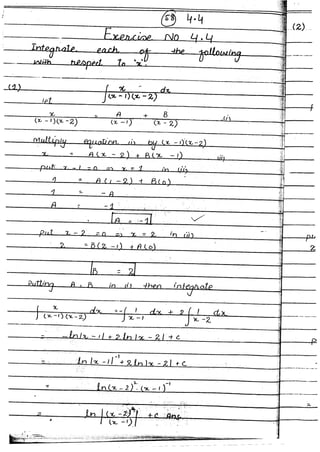

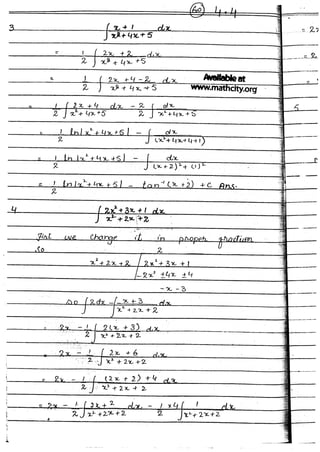
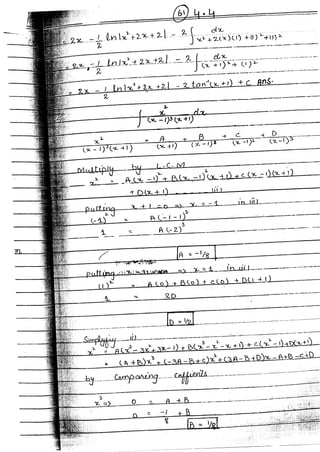
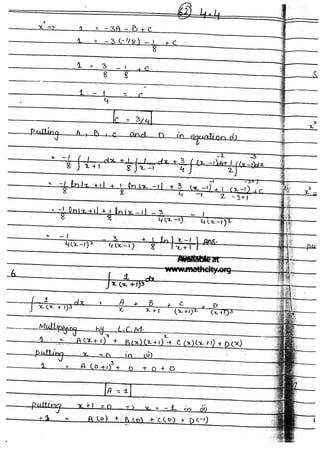
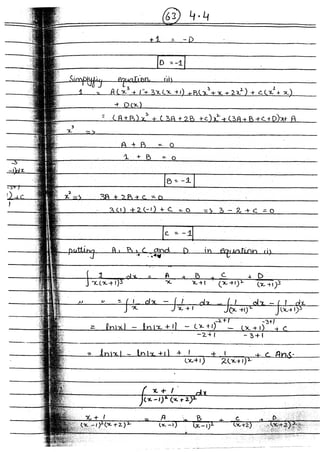
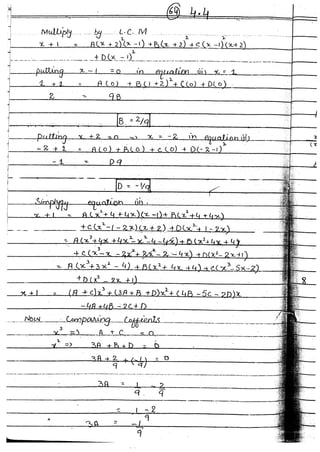


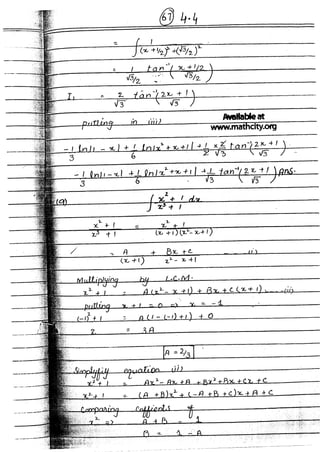
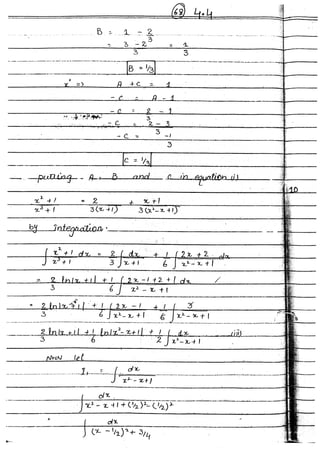
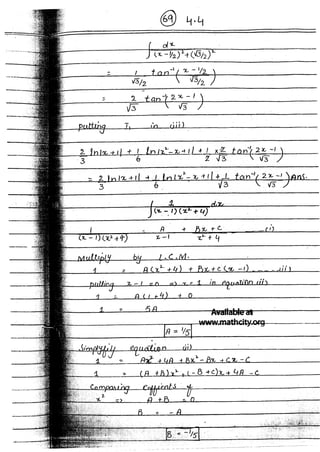
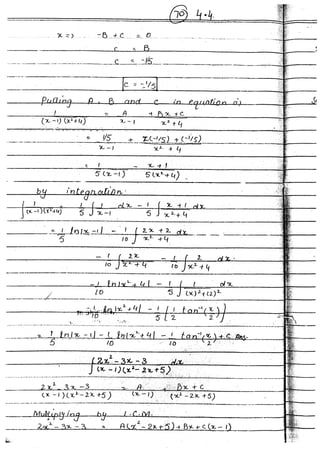


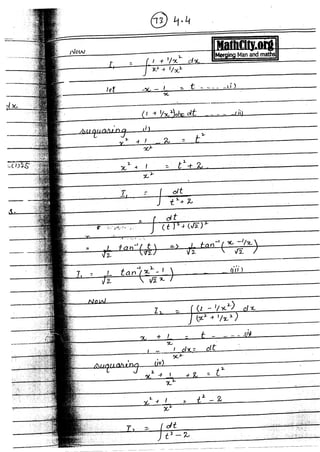
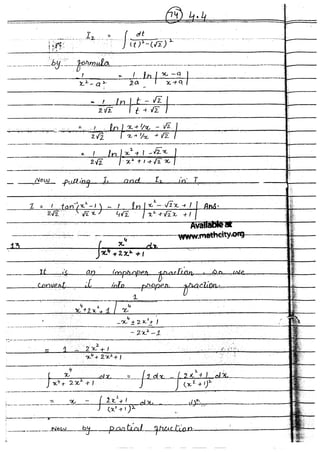
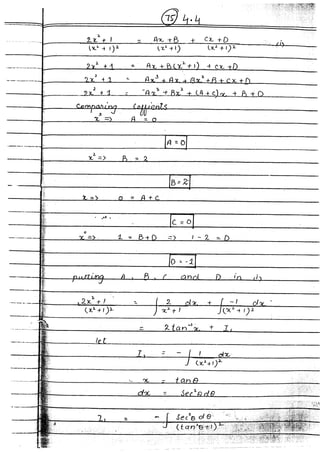

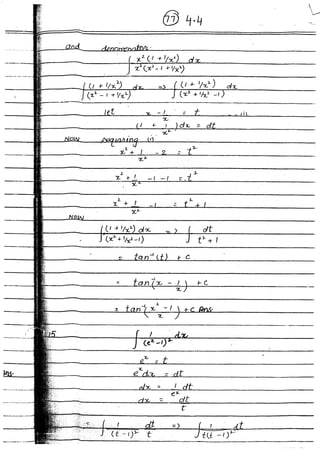

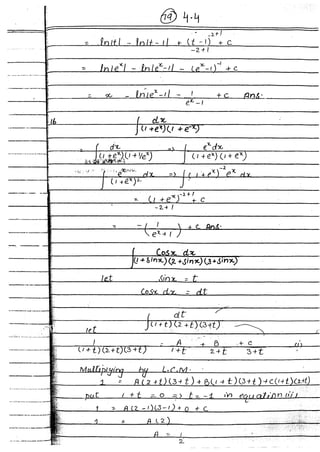
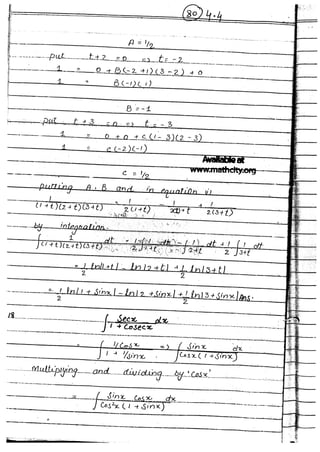
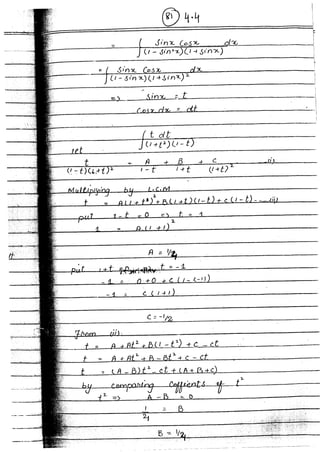
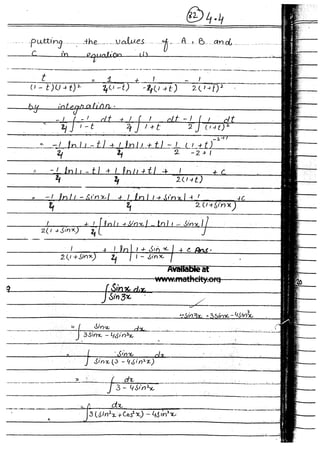


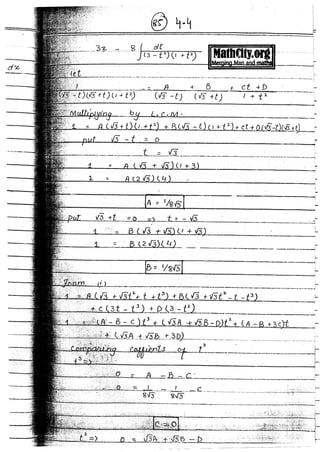
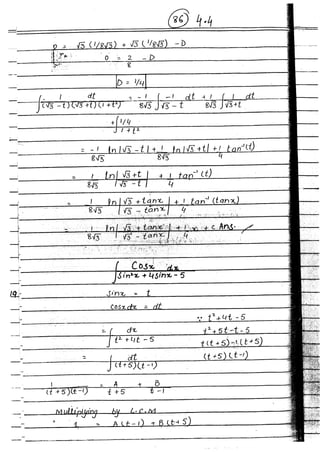
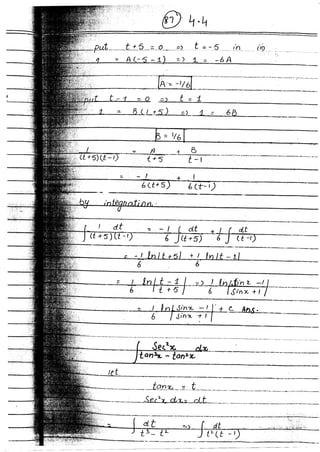
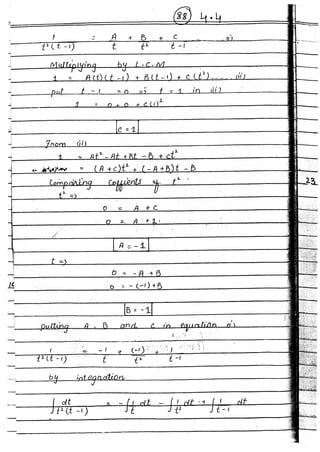
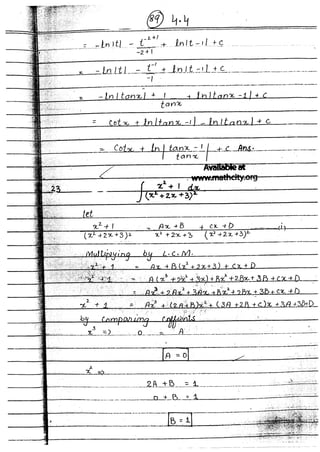
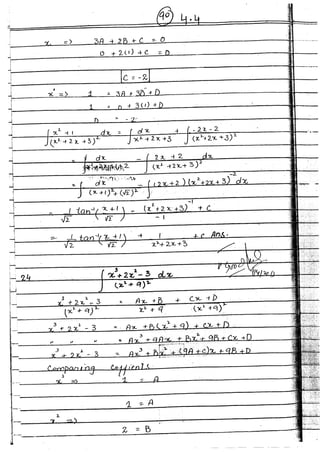
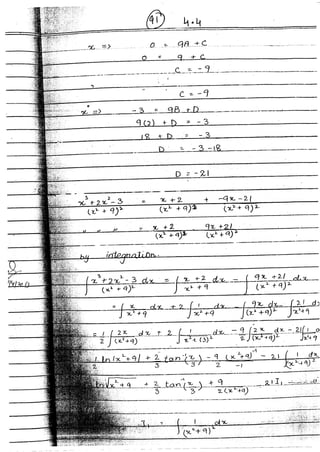
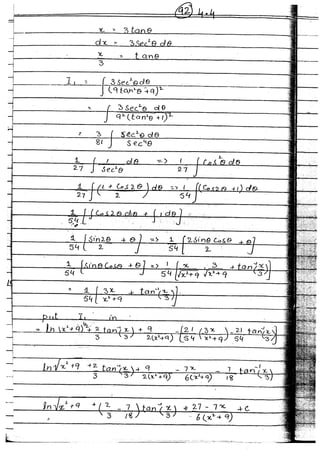
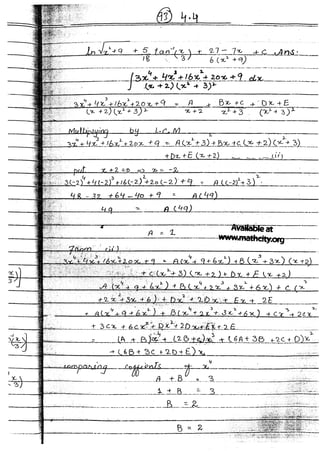

Ad
Recommended
Electric potential energy in a uniform field
Electric potential energy in a uniform fieldvicky vicky
╠²
A uniform electric field is created between parallel metal plates that exerts a constant downward force on a positive test charge. The work done by the electric field on the charge is equal to the charge times the electric field times the distance moved. This work done can be represented by a potential energy function where the potential energy is equal to the charge times the electric field times the height. If the charge moves downward with the field, the potential energy decreases, and if it moves upward against the field, the potential energy increases.Chap 04 solutions_ex_4.3_calculus
Chap 04 solutions_ex_4.3_calculusvicky vicky
╠²
The document discusses techniques for integration by parts. It provides examples of applying integration by parts to solve 25 questions involving integrals of trigonometric, exponential, and polynomial functions. For each question, it shows the steps used to derive an anti-derivative or reduction formula through repeated applications of integration by parts.Chap 04 solutions_ex_4.2
Chap 04 solutions_ex_4.2vicky vicky
╠²
This document contains techniques for integrating equations presented as solutions to 40 questions. Each question solution provides the setup of the integral using substitution or another technique like completing the square. Contact information is provided for Aqeel Nawaz, the author and preparer of the document.Operating systems
Operating systemsvicky vicky
╠²
This document provides an overview of system software and operating systems. It defines system software as programs that control and maintain computer operations, which include operating systems and utility programs. The document describes the functions of operating systems such as starting up and shutting down computers, providing user interfaces, managing memory, tasks, and devices. It also summarizes different types of operating systems like stand-alone systems including Windows 7, Mac OS X, Linux; server systems like Windows Server 2008; and embedded systems like Android and BlackBerry.Network
Networkvicky vicky
╠²
The document discusses computer communications and networking. It describes how computers transfer data through communication channels and devices. Examples of computer communications include texting, picture messaging, video chatting, and wireless internet access. Networks connect computers to allow sharing of hardware, data, software and more. Common network types include local area networks (LANs), wide area networks (WANs), and wireless networks. The document also examines networking standards, topologies, and communications devices like modems, routers, and switches that allow data transfer between connected computers and networks.Database
Databasevicky vicky
╠²
Databases organize data into collections that can be easily accessed, managed, and shared. A database management system allows users to create, modify, and retrieve data from a database. It also provides tools like query languages and report generators. Database administrators ensure the security and integrity of the database through techniques such as backups, access controls, and change management.Output OR Output devices
Output OR Output devicesvicky vicky
╠²
This document discusses different types of computer output devices. It describes displays like monitors that visually output text and graphics. Printers are discussed as devices that print text and graphics on paper. Audio output devices like speakers, headphones, and earbuds are covered as playing sound. Other output devices mentioned include data projectors for projecting computer displays onto larger screens. Key aspects of different display technologies and factors to consider when choosing output devices are highlighted. Input OR Input devices
Input OR Input devicesvicky vicky
╠²
The document discusses different types of computer input, including data, instructions, programs, commands, and user responses. It describes several common input devices like the keyboard, mouse, touch screens, touch pads, and pen input. The keyboard allows users to enter text, the mouse is a pointing device controlled by hand movements, touch screens are touch-sensitive display screens, and pen input involves using a stylus to write or draw on a flat surface.Transformers basic electrical engineering
Transformers basic electrical engineeringvicky vicky
╠²
1. A transformer is a device that converts alternating current (AC) of one voltage to another voltage without changing the frequency. It consists of coils wrapped around a common core and uses electromagnetic induction.
2. Nikola Tesla proposed using transformers to increase voltage for efficient power transmission over long distances, then step it back down for safe distribution and use. This system replaced the inefficient direct current system developed by Edison.
3. Transformers allow efficient transmission of power by reducing current and thus transmission losses, while maintaining the same power level. They are essential components for modern power distribution systems.Biot and savarat law
Biot and savarat law vicky vicky
╠²
The document discusses the magnetic field created by moving charges and currents. It introduces the concept of the magnetic field created by a single moving charge (Biot-Savart law) and a current element. It then expands this to discuss how the total magnetic field is calculated by integrating these infinitesimal fields over all current elements using Ampere's law. Several examples are given to illustrate these principles, including the magnetic field around a long straight wire and how Ampere's law relates the line integral of B around a closed path to the current passing through the enclosed area. The document concludes by discussing how magnetic properties originate at the atomic level due to electron orbits and spins, defining the Bohr magneton as the fundamental unit of magnetic momentMagnetic fields
Magnetic fieldsvicky vicky
╠²
This document discusses magnetic fields and their properties. It explains that magnets have two poles, north and south, and that like poles repel while unlike poles attract. It defines magnetic fields as representing magnetic forces that act at a distance without physical contact. It describes magnetic field lines and their properties, including that their direction shows the field orientation and strength increases with closer spacing. It discusses the force on moving charges in magnetic fields, including how this causes circular or spiral motion, and explains the Hall effect where a magnetic field perpendicular to current flow in a conductor creates a voltage across it.Motors
Motorsvicky vicky
╠²
This document discusses different types of electric motors, including AC motors, DC motors, and brushless DC motors. It provides details on the parts and operation of AC motors like synchronous speed calculations. It also covers single-phase motor types like split-phase, capacitor-start, and permanent split-capacitor motors. For DC motors it discusses classifications, armature voltage control, and shunt field control. Brushless DC motors are described as using transistors controlled by encoders to replace brushes.Filtration
Filtrationvicky vicky
╠²
Filtration is a process used to separate solids from liquids or gases by passing them through a porous medium. The main objectives of filtration are to produce clean drinking water, effluent, air, and prevent furnace fouling. Key types of filters are cake filters, clarifying filters, and cross-flow filters. Cake filters separate large amounts of solids, clarifying filters remove small amounts of solids, and cross-flow filters use high liquid velocity to prevent solids buildup. Selection factors for filters include slurry properties, throughput needs, and whether the solid or liquid product is more valuable. Common filtration equipment includes rotary drum filters, plate and frame presses, and bag filters.Crystallization
Crystallization vicky vicky
╠²
Crystallization is a technique used to purify solid compounds from a homogeneous solution by controlling the formation of solid crystals. It involves two main stages - crystal nucleation where small particles or nuclei form, and crystal growth where the nuclei grow in size. The process is based on principles of solubility where impurities are excluded from the growing crystals which can then be separated. Proper control of factors like cooling rate, agitation, supersaturation, and impurities is important to control crystal size and yield. Various types of crystallizers exist that employ different cooling and agitation methods for continuous crystallization in industrial applications like detergents, fertilizers, foods, and pharmaceuticals. Mixing
Mixingvicky vicky
╠²
This document discusses mixing in industrial processes. It defines mixing as manipulating a heterogeneous system to make it more homogeneous by intermingling two or more separate components. The types of mixing covered include different materials like solids, liquids, and gases. The mechanisms of mixing include shear, diffusive, and convective mixing. Common mixers are tumbling mixers, convective mixers, ribbon blenders, and others. Factors that impact mixing include mixer selection, mixing time, power consumption, and degree of mixing achieved. Agitation is also discussed and compared to mixing.Separation, screening
Separation, screening vicky vicky
╠²
This document discusses separation, screening, and classification techniques. It describes separation as using techniques to separate one material from another, which is important in chemical manufacturing. There are two main types of separation: diffusional separation, which involves transferring material between phases like distillation or crystallization; and mechanical separation, which relies on physical differences in particles like size, shape, or density. Screening is a type of mechanical separation that divides mixtures into fractions based on particle size by using screens with different sized meshes or openings. The document provides details on screening terminology, equipment, and material balance calculations.Nuclear fission
Nuclear fissionvicky vicky
╠²
This document discusses nuclear fission, including its history, the fission chain reaction process, nuclear reactors, and applications. It describes how nuclear fission was discovered in 1938 and involves splitting uranium-235 atoms with neutrons, releasing energy and up to 3 neutrons to split more atoms. A self-sustaining chain reaction can occur in a nuclear reactor, where the heat generated is used to produce steam to power generators and produce electricity. Nuclear fission is applied in nuclear power plants, nuclear weapons, and medical and scientific research.Waves
Wavesvicky vicky
╠²
The document discusses oscillatory motion and waves. It begins by introducing waves created by dropping a pebble in water, with the waves moving outward in expanding circles. It then discusses the main types of waves - mechanical and electromagnetic. Mechanical waves require a medium and examples include sound and water waves, while electromagnetic waves do not require a medium and include light, radio waves, and x-rays. The document goes on to define key variables of wave motion including wavelength, period, frequency, and amplitude. It also discusses the direction of particle displacement in transverse and longitudinal waves. Finally, it covers simple harmonic motion and how the acceleration, velocity, and force are related for objects undergoing SHM.Air pollution
Air pollutionvicky vicky
╠²
The document discusses air pollution and its causes and effects. It begins by introducing the group members and providing an outline of the topics to be discussed, which include the introduction, types, causes, effects, historical disasters, and references related to air pollution. It then defines air pollution as the presence of gases and particles in the air that are harmful to humans, plants, and animals. The document goes on to discuss the different types of air pollution including man-made sources such as domestic, vehicular, and industrial activities, as well as natural sources like volcanic eruptions and dust storms. It also examines the causes of air pollution including the burning of fossil fuels, agricultural activities, exhaust from factories and industries, and mining operations.OBSESSIVE COMPULSIVE DISORDER.pptx IN 5TH SEMESTER B.SC NURSING, 2ND YEAR GNM...
OBSESSIVE COMPULSIVE DISORDER.pptx IN 5TH SEMESTER B.SC NURSING, 2ND YEAR GNM...parmarjuli1412
╠²
OBSESSIVE COMPULSIVE DISORDER INCLUDED TOPICS ARE INTRODUCTION, DEFINITION OF OBSESSION, DEFINITION OF COMPULSION, MEANING OF OBSESSION AND COMPULSION, DEFINITION OF OBSESSIVE COMPULSIVE DISORDER, EPIDERMIOLOGY OF OCD, ETIOLOGICAL FACTORS OF OCD, CLINICAL SIGN AND SYMPTOMS OF OBSESSION AND COMPULSION, MANAGEMENT INCLUDED PHARMACOTHERAPY(ANTIDEPRESSANT DRUG+ANXIOLYTIC DRUGS), PSYCHOTHERAPY, NURSING MANAGEMENT(ASSESSMENT+DIAGNOSIS+NURSING INTERVENTION+EVALUATION)) F-BLOCK ELEMENTS POWER POINT PRESENTATIONS
F-BLOCK ELEMENTS POWER POINT PRESENTATIONSmprpgcwa2024
╠²
F-block elements are a group of elements in the periodic table that have partially filled f-orbitals. They are also known as inner transition elements. F-block elements are divided into two series:
1.Lanthanides (La- Lu) These elements are also known as rare earth elements.
2.Actinides (Ac- Lr): These elements are radioactive and have complex electronic configurations.
F-block elements exhibit multiple oxidation states due to the availability of f-orbitals.
2. Many f-block compounds are colored due to f-f transitions.
3. F-block elements often exhibit paramagnetic or ferromagnetic behavior.4. Actinides are radioactive.
F-block elements are used as catalysts in various industrial processes.
Actinides are used in nuclear reactors and nuclear medicine.
F-block elements are used in lasers and phosphors due to their luminescent properties.
F-block elements have unique electronic and magnetic properties.Intellectual Property Right (Jurisprudence).pptx
Intellectual Property Right (Jurisprudence).pptxVishal Chanalia
╠²
Intellectual property corresponds to ideas owned by a person or a firm and thus subjected to legal protection under the law.
The main purpose of intellectual property is to give encouragement to the innovators of new concepts by giving them the opportunity to make sufficient profits from their inventions and recover their manufacturing costs and efforts. How to Manage Different Customer Addresses in Odoo 18 Accounting
How to Manage Different Customer Addresses in Odoo 18 AccountingCeline George
╠²
A business often have customers with multiple locations such as office, warehouse, home addresses and this feature allows us to associate with different addresses with each customer streamlining the process of creating sales order invoices and delivery orders.VCE Literature Section A Exam Response Guide
VCE Literature Section A Exam Response Guidejpinnuck
╠²
This practical guide shows students of Unit 3&4 VCE Literature how to write responses to Section A of the exam. Including a range of examples writing about different types of texts, this guide:
*Breaks down and explains what Q1 and Q2 tasks involve and expect
*Breaks down example responses for each question
*Explains and scaffolds students to write responses for each question
*Includes a comprehensive range of sentence starters and vocabulary for responding to each question
*Includes critical theory vocabulary╠² lists to support Q2 responsesHistoPathology Ppt. Arshita Gupta for Diploma
HistoPathology Ppt. Arshita Gupta for Diplomaarshitagupta674
╠²
Hello everyone please suggest your views and likes so that I uploaded more study materials
In this slide full HistoPathology according to diploma course available like fixation
Tissue processing , staining etc
More Related Content
More from vicky vicky (14)
Database
Databasevicky vicky
╠²
Databases organize data into collections that can be easily accessed, managed, and shared. A database management system allows users to create, modify, and retrieve data from a database. It also provides tools like query languages and report generators. Database administrators ensure the security and integrity of the database through techniques such as backups, access controls, and change management.Output OR Output devices
Output OR Output devicesvicky vicky
╠²
This document discusses different types of computer output devices. It describes displays like monitors that visually output text and graphics. Printers are discussed as devices that print text and graphics on paper. Audio output devices like speakers, headphones, and earbuds are covered as playing sound. Other output devices mentioned include data projectors for projecting computer displays onto larger screens. Key aspects of different display technologies and factors to consider when choosing output devices are highlighted. Input OR Input devices
Input OR Input devicesvicky vicky
╠²
The document discusses different types of computer input, including data, instructions, programs, commands, and user responses. It describes several common input devices like the keyboard, mouse, touch screens, touch pads, and pen input. The keyboard allows users to enter text, the mouse is a pointing device controlled by hand movements, touch screens are touch-sensitive display screens, and pen input involves using a stylus to write or draw on a flat surface.Transformers basic electrical engineering
Transformers basic electrical engineeringvicky vicky
╠²
1. A transformer is a device that converts alternating current (AC) of one voltage to another voltage without changing the frequency. It consists of coils wrapped around a common core and uses electromagnetic induction.
2. Nikola Tesla proposed using transformers to increase voltage for efficient power transmission over long distances, then step it back down for safe distribution and use. This system replaced the inefficient direct current system developed by Edison.
3. Transformers allow efficient transmission of power by reducing current and thus transmission losses, while maintaining the same power level. They are essential components for modern power distribution systems.Biot and savarat law
Biot and savarat law vicky vicky
╠²
The document discusses the magnetic field created by moving charges and currents. It introduces the concept of the magnetic field created by a single moving charge (Biot-Savart law) and a current element. It then expands this to discuss how the total magnetic field is calculated by integrating these infinitesimal fields over all current elements using Ampere's law. Several examples are given to illustrate these principles, including the magnetic field around a long straight wire and how Ampere's law relates the line integral of B around a closed path to the current passing through the enclosed area. The document concludes by discussing how magnetic properties originate at the atomic level due to electron orbits and spins, defining the Bohr magneton as the fundamental unit of magnetic momentMagnetic fields
Magnetic fieldsvicky vicky
╠²
This document discusses magnetic fields and their properties. It explains that magnets have two poles, north and south, and that like poles repel while unlike poles attract. It defines magnetic fields as representing magnetic forces that act at a distance without physical contact. It describes magnetic field lines and their properties, including that their direction shows the field orientation and strength increases with closer spacing. It discusses the force on moving charges in magnetic fields, including how this causes circular or spiral motion, and explains the Hall effect where a magnetic field perpendicular to current flow in a conductor creates a voltage across it.Motors
Motorsvicky vicky
╠²
This document discusses different types of electric motors, including AC motors, DC motors, and brushless DC motors. It provides details on the parts and operation of AC motors like synchronous speed calculations. It also covers single-phase motor types like split-phase, capacitor-start, and permanent split-capacitor motors. For DC motors it discusses classifications, armature voltage control, and shunt field control. Brushless DC motors are described as using transistors controlled by encoders to replace brushes.Filtration
Filtrationvicky vicky
╠²
Filtration is a process used to separate solids from liquids or gases by passing them through a porous medium. The main objectives of filtration are to produce clean drinking water, effluent, air, and prevent furnace fouling. Key types of filters are cake filters, clarifying filters, and cross-flow filters. Cake filters separate large amounts of solids, clarifying filters remove small amounts of solids, and cross-flow filters use high liquid velocity to prevent solids buildup. Selection factors for filters include slurry properties, throughput needs, and whether the solid or liquid product is more valuable. Common filtration equipment includes rotary drum filters, plate and frame presses, and bag filters.Crystallization
Crystallization vicky vicky
╠²
Crystallization is a technique used to purify solid compounds from a homogeneous solution by controlling the formation of solid crystals. It involves two main stages - crystal nucleation where small particles or nuclei form, and crystal growth where the nuclei grow in size. The process is based on principles of solubility where impurities are excluded from the growing crystals which can then be separated. Proper control of factors like cooling rate, agitation, supersaturation, and impurities is important to control crystal size and yield. Various types of crystallizers exist that employ different cooling and agitation methods for continuous crystallization in industrial applications like detergents, fertilizers, foods, and pharmaceuticals. Mixing
Mixingvicky vicky
╠²
This document discusses mixing in industrial processes. It defines mixing as manipulating a heterogeneous system to make it more homogeneous by intermingling two or more separate components. The types of mixing covered include different materials like solids, liquids, and gases. The mechanisms of mixing include shear, diffusive, and convective mixing. Common mixers are tumbling mixers, convective mixers, ribbon blenders, and others. Factors that impact mixing include mixer selection, mixing time, power consumption, and degree of mixing achieved. Agitation is also discussed and compared to mixing.Separation, screening
Separation, screening vicky vicky
╠²
This document discusses separation, screening, and classification techniques. It describes separation as using techniques to separate one material from another, which is important in chemical manufacturing. There are two main types of separation: diffusional separation, which involves transferring material between phases like distillation or crystallization; and mechanical separation, which relies on physical differences in particles like size, shape, or density. Screening is a type of mechanical separation that divides mixtures into fractions based on particle size by using screens with different sized meshes or openings. The document provides details on screening terminology, equipment, and material balance calculations.Nuclear fission
Nuclear fissionvicky vicky
╠²
This document discusses nuclear fission, including its history, the fission chain reaction process, nuclear reactors, and applications. It describes how nuclear fission was discovered in 1938 and involves splitting uranium-235 atoms with neutrons, releasing energy and up to 3 neutrons to split more atoms. A self-sustaining chain reaction can occur in a nuclear reactor, where the heat generated is used to produce steam to power generators and produce electricity. Nuclear fission is applied in nuclear power plants, nuclear weapons, and medical and scientific research.Waves
Wavesvicky vicky
╠²
The document discusses oscillatory motion and waves. It begins by introducing waves created by dropping a pebble in water, with the waves moving outward in expanding circles. It then discusses the main types of waves - mechanical and electromagnetic. Mechanical waves require a medium and examples include sound and water waves, while electromagnetic waves do not require a medium and include light, radio waves, and x-rays. The document goes on to define key variables of wave motion including wavelength, period, frequency, and amplitude. It also discusses the direction of particle displacement in transverse and longitudinal waves. Finally, it covers simple harmonic motion and how the acceleration, velocity, and force are related for objects undergoing SHM.Air pollution
Air pollutionvicky vicky
╠²
The document discusses air pollution and its causes and effects. It begins by introducing the group members and providing an outline of the topics to be discussed, which include the introduction, types, causes, effects, historical disasters, and references related to air pollution. It then defines air pollution as the presence of gases and particles in the air that are harmful to humans, plants, and animals. The document goes on to discuss the different types of air pollution including man-made sources such as domestic, vehicular, and industrial activities, as well as natural sources like volcanic eruptions and dust storms. It also examines the causes of air pollution including the burning of fossil fuels, agricultural activities, exhaust from factories and industries, and mining operations.Recently uploaded (20)
OBSESSIVE COMPULSIVE DISORDER.pptx IN 5TH SEMESTER B.SC NURSING, 2ND YEAR GNM...
OBSESSIVE COMPULSIVE DISORDER.pptx IN 5TH SEMESTER B.SC NURSING, 2ND YEAR GNM...parmarjuli1412
╠²
OBSESSIVE COMPULSIVE DISORDER INCLUDED TOPICS ARE INTRODUCTION, DEFINITION OF OBSESSION, DEFINITION OF COMPULSION, MEANING OF OBSESSION AND COMPULSION, DEFINITION OF OBSESSIVE COMPULSIVE DISORDER, EPIDERMIOLOGY OF OCD, ETIOLOGICAL FACTORS OF OCD, CLINICAL SIGN AND SYMPTOMS OF OBSESSION AND COMPULSION, MANAGEMENT INCLUDED PHARMACOTHERAPY(ANTIDEPRESSANT DRUG+ANXIOLYTIC DRUGS), PSYCHOTHERAPY, NURSING MANAGEMENT(ASSESSMENT+DIAGNOSIS+NURSING INTERVENTION+EVALUATION)) F-BLOCK ELEMENTS POWER POINT PRESENTATIONS
F-BLOCK ELEMENTS POWER POINT PRESENTATIONSmprpgcwa2024
╠²
F-block elements are a group of elements in the periodic table that have partially filled f-orbitals. They are also known as inner transition elements. F-block elements are divided into two series:
1.Lanthanides (La- Lu) These elements are also known as rare earth elements.
2.Actinides (Ac- Lr): These elements are radioactive and have complex electronic configurations.
F-block elements exhibit multiple oxidation states due to the availability of f-orbitals.
2. Many f-block compounds are colored due to f-f transitions.
3. F-block elements often exhibit paramagnetic or ferromagnetic behavior.4. Actinides are radioactive.
F-block elements are used as catalysts in various industrial processes.
Actinides are used in nuclear reactors and nuclear medicine.
F-block elements are used in lasers and phosphors due to their luminescent properties.
F-block elements have unique electronic and magnetic properties.Intellectual Property Right (Jurisprudence).pptx
Intellectual Property Right (Jurisprudence).pptxVishal Chanalia
╠²
Intellectual property corresponds to ideas owned by a person or a firm and thus subjected to legal protection under the law.
The main purpose of intellectual property is to give encouragement to the innovators of new concepts by giving them the opportunity to make sufficient profits from their inventions and recover their manufacturing costs and efforts. How to Manage Different Customer Addresses in Odoo 18 Accounting
How to Manage Different Customer Addresses in Odoo 18 AccountingCeline George
╠²
A business often have customers with multiple locations such as office, warehouse, home addresses and this feature allows us to associate with different addresses with each customer streamlining the process of creating sales order invoices and delivery orders.VCE Literature Section A Exam Response Guide
VCE Literature Section A Exam Response Guidejpinnuck
╠²
This practical guide shows students of Unit 3&4 VCE Literature how to write responses to Section A of the exam. Including a range of examples writing about different types of texts, this guide:
*Breaks down and explains what Q1 and Q2 tasks involve and expect
*Breaks down example responses for each question
*Explains and scaffolds students to write responses for each question
*Includes a comprehensive range of sentence starters and vocabulary for responding to each question
*Includes critical theory vocabulary╠² lists to support Q2 responsesHistoPathology Ppt. Arshita Gupta for Diploma
HistoPathology Ppt. Arshita Gupta for Diplomaarshitagupta674
╠²
Hello everyone please suggest your views and likes so that I uploaded more study materials
In this slide full HistoPathology according to diploma course available like fixation
Tissue processing , staining etc
How payment terms are configured in Odoo 18
How payment terms are configured in Odoo 18Celine George
╠²
Payment terms in Odoo 18 help define the conditions for when invoices are due. This feature can split payments into multiple parts and automate due dates based on specific rules.Chalukyas of Gujrat, Solanki Dynasty NEP.pptx
Chalukyas of Gujrat, Solanki Dynasty NEP.pptxDr. Ravi Shankar Arya Mahila P. G. College, Banaras Hindu University, Varanasi, India.
╠²
This presentation has been made keeping in mind the students of undergraduate and postgraduate level. In this slide try to present the brief history of Chaulukyas of Gujrat up to Kumarpala To keep the facts in a natural form and to display the material in more detail, the help of various books, websites and online medium has been taken. Whatever medium the material or facts have been taken from, an attempt has been made by the presenter to give their reference at the end.
Chaulukya or Solanki was one of the Rajputs born from Agnikul. In the Vadnagar inscription, the origin of this dynasty is told from Brahma's Chauluk or Kamandalu. They ruled in Gujarat from the latter half of the tenth century to the beginning of the thirteenth century. Their capital was in Anahilwad. It is not certain whether it had any relation with the Chalukya dynasty of the south or not. It is worth mentioning that the name of the dynasty of the south was 'Chaluky' while the dynasty of Gujarat has been called 'Chaulukya'. The rulers of this dynasty were the supporters and patrons of Jainism.INDUCTIVE EFFECT slide for first prof pharamacy students
INDUCTIVE EFFECT slide for first prof pharamacy studentsSHABNAM FAIZ
╠²
The inductive effect is the electron-withdrawing or electron-donating effect transmitted through sigma (Žā) bonds in a molecule due to differences in electronegativity between atoms.
---
¤ö╣ Definition:
The inductive effect is the permanent shifting of electrons in a sigma bond caused by the electronegativity difference of atoms, resulting in partial charges within the molecule.A Visual Introduction to the Prophet Jeremiah
A Visual Introduction to the Prophet JeremiahSteve Thomason
╠²
These images will give you a visual guide to both the context and the flow of the story of the prophet Jeremiah. Feel free to use these in your study, preaching, and teaching.University of Ghana Cracks Down on Misconduct: Over 100 Students Sanctioned
University of Ghana Cracks Down on Misconduct: Over 100 Students SanctionedKweku Zurek
╠²
University of Ghana Cracks Down on Misconduct: Over 100 Students Sanctioned
Q1_ENGLISH_PPT_WEEK 1 power point grade 3 Quarter 1 week 1
Q1_ENGLISH_PPT_WEEK 1 power point grade 3 Quarter 1 week 1jutaydeonne
╠²
Grade 3 Quarter 1 Week 1 English part 2Birnagar High School Platinum Jubilee Quiz.pptx
Birnagar High School Platinum Jubilee Quiz.pptxSourav Kr Podder
╠²
Birnagar High School Platinum Jubilee Celebration QuizFilipino 9 Maikling Kwento Ang Ama Panitikang Asiyano
Filipino 9 Maikling Kwento Ang Ama Panitikang Asiyanosumadsadjelly121997
╠²
Filipino 9 Maikling Kwento Ang Ama Panitikang AsiyanoAprendendo Arquitetura Framework Salesforce - Dia 02
Aprendendo Arquitetura Framework Salesforce - Dia 02Mauricio Alexandre Silva
╠²
Aprendendo Arquitetura Framework Salesforce - Dia 02
Plate Tectonic Boundaries and Continental Drift Theory
Plate Tectonic Boundaries and Continental Drift TheoryMarie
╠²
This 28 slide presentation covers the basics of plate tectonics and continental drift theory. It is an effective introduction into a full plate tectonics unit study, but does not cover faults, stress, seismic waves, or seafloor spreading.
To download PDF, visit The Homeschool Daily. We will be uploading more slideshows to follow this one. Blessings, Marie Vitamin and Nutritional Deficiencies.pptx
Vitamin and Nutritional Deficiencies.pptxVishal Chanalia
╠²
Vitamin and nutritional deficiency occurs when the body does not receive enough essential nutrients, such as vitamins and minerals, needed for proper functioning. This can lead to various health problems, including weakened immunity, stunted growth, fatigue, poor wound healing, cognitive issues, and increased susceptibility to infections and diseases. Long-term deficiencies can cause serious and sometimes irreversible health complications.Romanticism in Love and Sacrifice An Analysis of Oscar WildeŌĆÖs The Nightingal...
Romanticism in Love and Sacrifice An Analysis of Oscar WildeŌĆÖs The Nightingal...KaryanaTantri21
╠²
The story revolves around a college student who despairs not having a red rose as a condition for dancing with the girl he loves. The nightingale hears his complaint and offers to create the red rose at the cost of his life. He sang a love song all night with his chest stuck to the thorns of the rose tree. Finally, the red rose grew, but his sacrifice was in vain. The girl rejected the flower because it didnŌĆÖt match her outfit and preferred a jewellery gift. The student threw the flower on the street and returned to studying philosophyChalukyas of Gujrat, Solanki Dynasty NEP.pptx
Chalukyas of Gujrat, Solanki Dynasty NEP.pptxDr. Ravi Shankar Arya Mahila P. G. College, Banaras Hindu University, Varanasi, India.
╠²
Ad